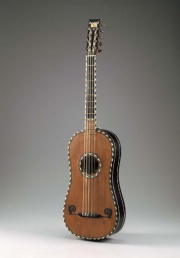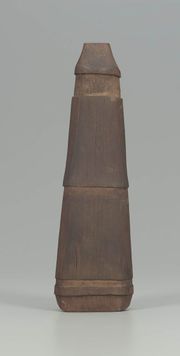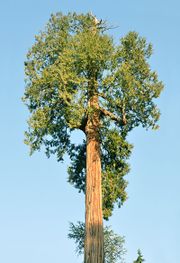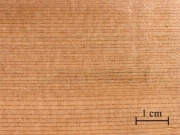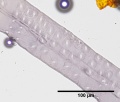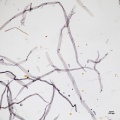Difference between revisions of "Giant arborvitae"
| (3 intermediate revisions by the same user not shown) | |||
| Line 1: | Line 1: | ||
| − | [[File: | + | [[File:Image3_802592.jpg|thumb|Guitar<br>MFA Acc. # 1993.576]] |
| − | + | [[File:17.2214-SC29687.jpg|thumb|Reed pipe<br>MFA Acc. # 17.2214]] | |
| − | |||
== Description == | == Description == | ||
A large red cedar, ''Thuja plicata or Thuja gigantea'', native to the northwestern United States, Canada, and Alaska. The giant arborvitae, or western red cedar, tree can reach 200 feet in height. It was introduced into England and France in 1853 for lumber and as an ornamental tree. These giant red cedars produce a soft, knot-free, reddish-brown, aromatic lumber. They weather to a silvery gray color and are very resistant to fungi and moisture. Red cedar wood was used by native Americans of the Pacific coast for giant war canoes and totem poles. Additionally fibers prepared from strips of the inner bark were woven into blankets, baskets, mats, and cords by the Haida, Salish, Kwakiutl and Tlingit tribes (King and Hartley 1979). Currently red cedar is used for shingles, poles, fences, tanks, closet liners, and cedar chests. | A large red cedar, ''Thuja plicata or Thuja gigantea'', native to the northwestern United States, Canada, and Alaska. The giant arborvitae, or western red cedar, tree can reach 200 feet in height. It was introduced into England and France in 1853 for lumber and as an ornamental tree. These giant red cedars produce a soft, knot-free, reddish-brown, aromatic lumber. They weather to a silvery gray color and are very resistant to fungi and moisture. Red cedar wood was used by native Americans of the Pacific coast for giant war canoes and totem poles. Additionally fibers prepared from strips of the inner bark were woven into blankets, baskets, mats, and cords by the Haida, Salish, Kwakiutl and Tlingit tribes (King and Hartley 1979). Currently red cedar is used for shingles, poles, fences, tanks, closet liners, and cedar chests. | ||
| − | [[File: | + | [[File:800px-Thuja plicata Vancouver.jpg|thumb|Western Red Cedar (''Thuja plicata'')]] |
| + | [[File:05_WesternRedCedar.jpg|thumb|Western Red Cedar (''Thuja plicata'')]] | ||
| − | |||
== Synonyms and Related Terms == | == Synonyms and Related Terms == | ||
''Thuja plicata; Thuja gigantea''; cèdre rouge (Fr.); Rotzeder (Deut.); cedro rosso (It.); cedro dulce (Esp.); tuia-gigante (Port.); stinking cedar; shinglewood; canoe cedar; western red cedar; British Columbia cedar; giant cedar; Pacific red cedar | ''Thuja plicata; Thuja gigantea''; cèdre rouge (Fr.); Rotzeder (Deut.); cedro rosso (It.); cedro dulce (Esp.); tuia-gigante (Port.); stinking cedar; shinglewood; canoe cedar; western red cedar; British Columbia cedar; giant cedar; Pacific red cedar | ||
| + | == Personal Risks == | ||
| − | == | + | Inhalation of dust and skin contact may cause allergic reactions. |
| + | == Physical and Chemical Properties == | ||
Color: red brown with yellow streaks. Rings: distinct. Pores:absent. Grain: faint. Rays: obscure. Soft, lightweight aromatic. | Color: red brown with yellow streaks. Rings: distinct. Pores:absent. Grain: faint. Rays: obscure. Soft, lightweight aromatic. | ||
| Line 25: | Line 26: | ||
| specific gravity = 0.38 | | specific gravity = 0.38 | ||
|} | |} | ||
| − | |||
| − | |||
| − | |||
| − | |||
| − | |||
| − | |||
| − | |||
| − | |||
| − | |||
| − | |||
| − | |||
== Additional Images == | == Additional Images == | ||
<gallery> | <gallery> | ||
| + | File:19_Arborvitae_100x_Rad.jpg|Giant arborvitae (''Thuja gigantea'') | ||
| + | File:19_Arborvitae_100x_Tan.jpg|Giant arborvitae (''Thuja gigantea'') | ||
File:19_Arborvitae_100x_Tran.jpg|Giant arborvitae (''Thuja gigantea'') | File:19_Arborvitae_100x_Tran.jpg|Giant arborvitae (''Thuja gigantea'') | ||
| − | File:W red cedar 40x.jpg|Western red cedar paper pulp | + | File:W red cedar 40x.jpg|Western red cedar paper pulp (''Thuja plicata'') |
| − | File:W red cedar 10x.jpg|Western red cedar paper pulp | + | File:W red cedar 10x.jpg|Western red cedar paper pulp (''Thuja plicata'') |
</gallery> | </gallery> | ||
| − | == | + | == Resources and Citations == |
| + | * R.King, E.Hartley, "Unusual Fibers Used in Northwest Coast Ethnographic Textiles, Their Preparation & Their Structure", ''Technology & Conservation'', 1/79. | ||
| + | |||
| + | * Alden Identification Services, Microscopic Wood Identification: [https://wood-identification.com/wood-types/ Link] | ||
| − | * | + | * West Coast Lumbermen's Association, Seattle, Wash.: air-ddry weight = 23 pcf |
* H.L.Edlin, ''What Wood is That?'', Viking Press, New York, 1969 | * H.L.Edlin, ''What Wood is That?'', Viking Press, New York, 1969 | ||
Latest revision as of 15:11, 3 September 2020
Description
A large red cedar, Thuja plicata or Thuja gigantea, native to the northwestern United States, Canada, and Alaska. The giant arborvitae, or western red cedar, tree can reach 200 feet in height. It was introduced into England and France in 1853 for lumber and as an ornamental tree. These giant red cedars produce a soft, knot-free, reddish-brown, aromatic lumber. They weather to a silvery gray color and are very resistant to fungi and moisture. Red cedar wood was used by native Americans of the Pacific coast for giant war canoes and totem poles. Additionally fibers prepared from strips of the inner bark were woven into blankets, baskets, mats, and cords by the Haida, Salish, Kwakiutl and Tlingit tribes (King and Hartley 1979). Currently red cedar is used for shingles, poles, fences, tanks, closet liners, and cedar chests.
Synonyms and Related Terms
Thuja plicata; Thuja gigantea; cèdre rouge (Fr.); Rotzeder (Deut.); cedro rosso (It.); cedro dulce (Esp.); tuia-gigante (Port.); stinking cedar; shinglewood; canoe cedar; western red cedar; British Columbia cedar; giant cedar; Pacific red cedar
Personal Risks
Inhalation of dust and skin contact may cause allergic reactions.
Physical and Chemical Properties
Color: red brown with yellow streaks. Rings: distinct. Pores:absent. Grain: faint. Rays: obscure. Soft, lightweight aromatic.
| Density | 23 ppcf |
|---|---|
| Molecular Weight | specific gravity = 0.38 |
Additional Images
Resources and Citations
- R.King, E.Hartley, "Unusual Fibers Used in Northwest Coast Ethnographic Textiles, Their Preparation & Their Structure", Technology & Conservation, 1/79.
- Alden Identification Services, Microscopic Wood Identification: Link
- West Coast Lumbermen's Association, Seattle, Wash.: air-ddry weight = 23 pcf
- H.L.Edlin, What Wood is That?, Viking Press, New York, 1969
- G.S.Brady, Materials Handbook, McGraw-Hill Book Co., New York, 1971 Comment: p. 808
- Michael McCann, Artist Beware, Watson-Guptill Publications, New York City, 1979
- Dictionary of Building Preservation, Ward Bucher, ed., John Wiley & Sons, Inc., New York City, 1996
